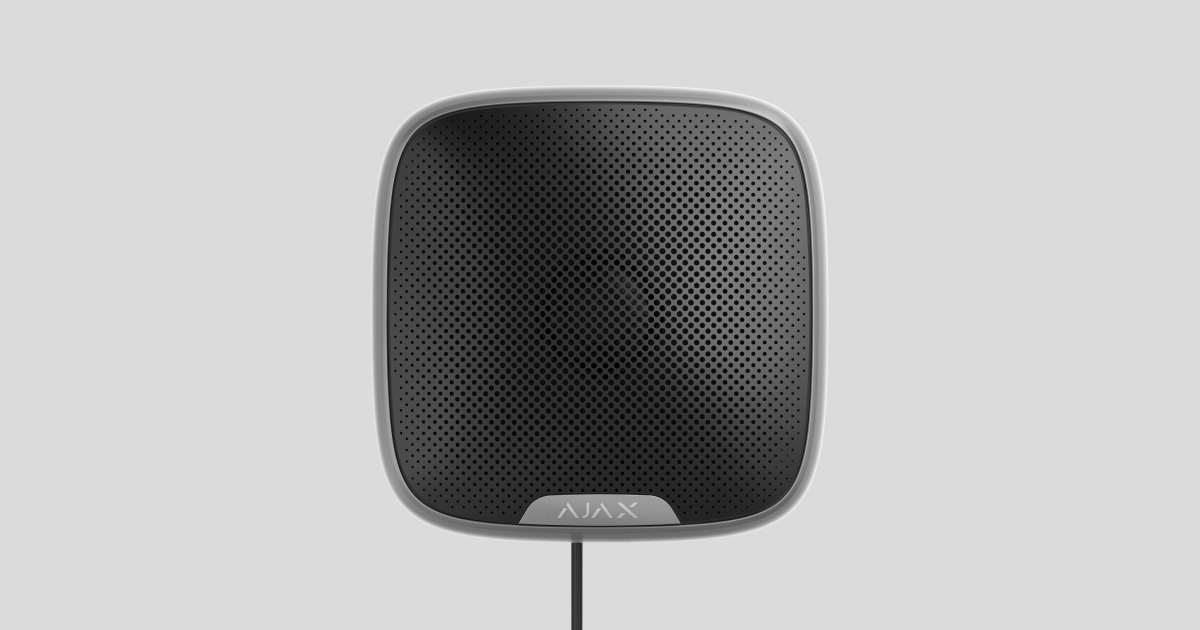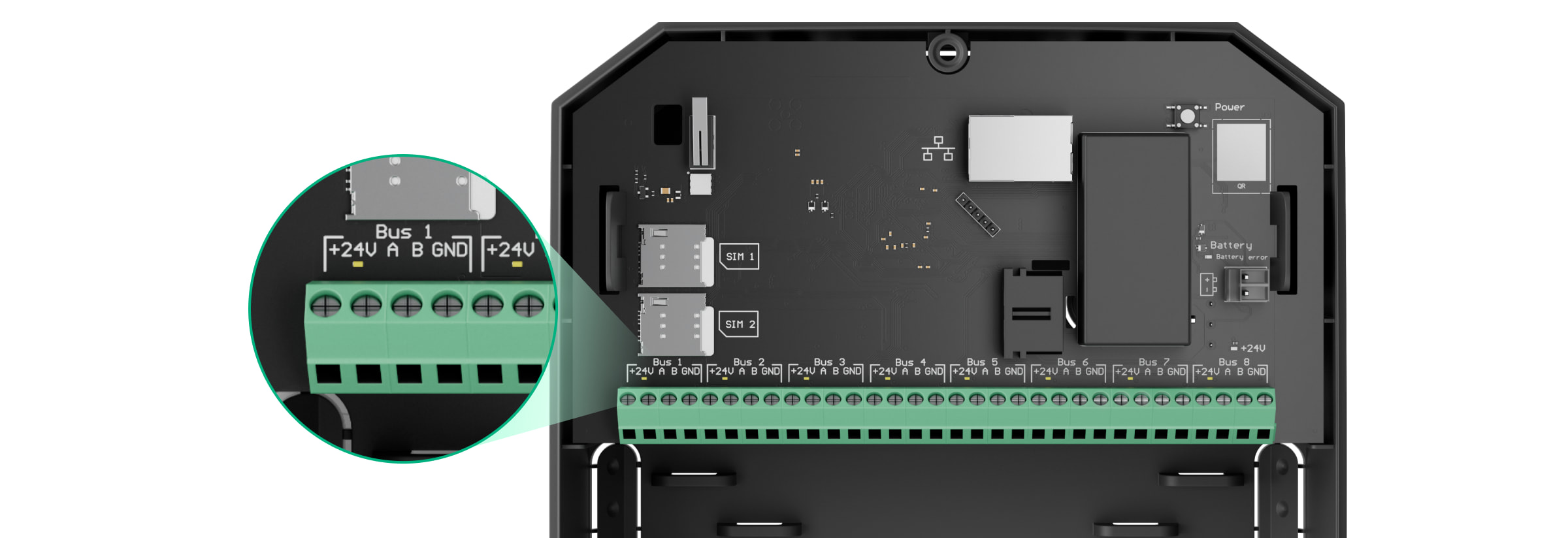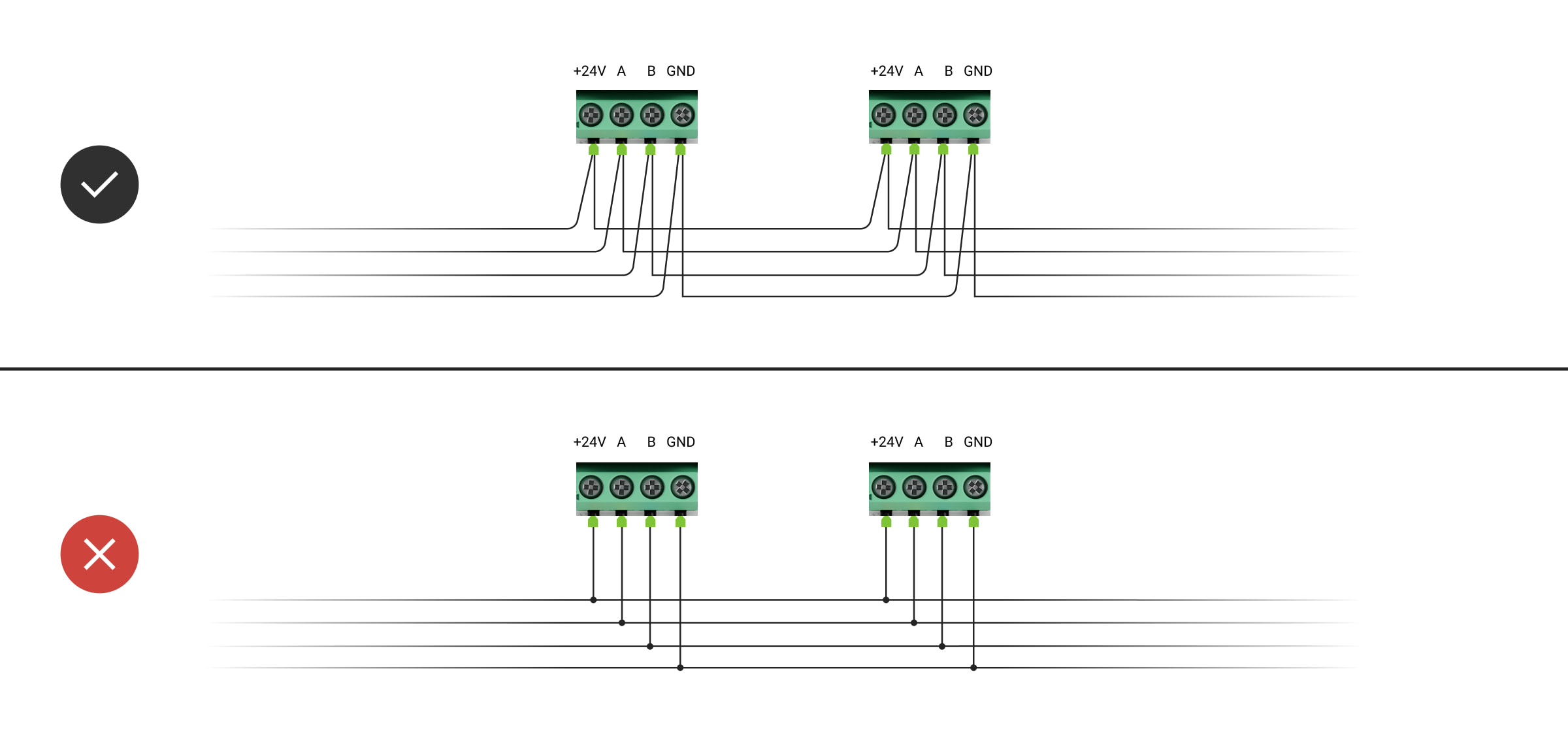Superior StreetSiren Fibra is a wired siren of the Ajax system. Equipped with a LED frame and piezoelectric alarm indicator producing sound volume up to 113 dB. For both indoor and outdoor installation.
The siren is compatible with Superior Hub Hybrid (2G) and Superior Hub Hybrid (4G). Connection to other hubs, radio signal range extenders, ocBridge Plus, and uartBridge is not provided.
Superior StreetSiren Fibra works as part of the Ajax system, exchanging data with the hub via the secure protocol of Fibra wired communication. The communication range is up to 2,000 m when connected via twisted pair U/UTP cat.5.
Superior StreetSiren Fibra is part of the wired Fibra devices line. The installation, sale, and administration of these devices are performed only by accredited Ajax partners.
Functional elements
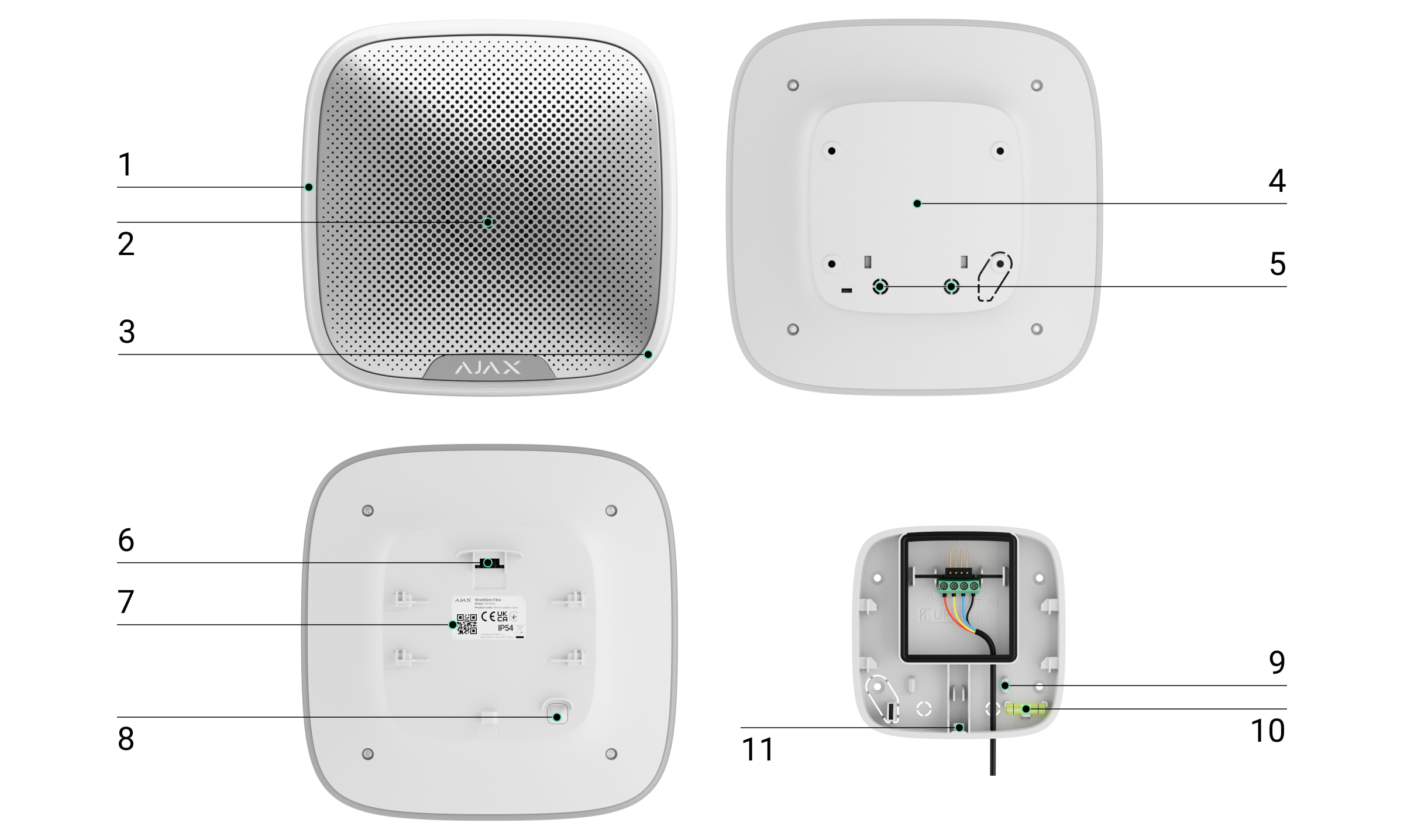
- LED frame.
- Siren buzzer, located under the fabric.
- LED indicator.
- SmartBracket mounting panel. To remove the panel, slide it down.
- Perforated part for cable output.
- Terminals for connecting Superior StreetSiren Fibra to the hub.
- QR code and ID (serial number) of the siren. Used for connection to the Ajax system.
- Tamper button. Triggers when an attempt is made to detach the device from the surface or remove it from the mounting panel.
- Fasteners to fix the cables with ties.
- Bubble level to check the inclination angle of the mounting during installation.
- The hole for attaching the SmartBracket mounting panel with a screw.
Operating principle
Superior StreetSiren Fibra is a wired siren of the Ajax system. The device is equipped with a piezoelectric buzzer for sound alerting and an LED frame for visual alerting. The siren has a sealed battery that is used to power the device. The battery is charged from the Fibra line and is used for indication as well as for notification of alarms and events.
In case of the Fibra line damage or an emergency power shortage, the backup battery will provide the siren with power to indicate and alert alarms and events.
Siren performs four tasks:
1. Informs about alarms. The siren responds to tamper triggering and system alarms, including a buzzer and LED backlight in less than a second, which scares off intruders and attracts attention.
2. Indicates the security status. The siren uses LED indication to notify that the object is armed, and reports about Delays When Entering/Leaving with sound and backlight. These functions will be useful when controlling the system with key fobs and keypads. In this case, the siren can remind you to disarm the system when you enter the object.
3. Chime. Sirens with a special sound inform about the triggering of the opening detectors when the system is disarmed. The feature is used, for example, in stores, to notify employees that someone has entered the building.
4. Notifies of triggering until the system is disarmed. The lower right corner of the siren’s LED frame flashes after the sound signal is played. Thanks to this option, users and passing patrols of security companies can see that the system was triggered.
Alarm volume and duration
By alarm the siren sounds from 3 seconds to 3 minutes, emitting a sound volume of 85 to 113 dB. In the Ajax apps, you can set the duration and volume of the alarm, as well as determine which detectors will activate the siren. More details about this feature in the section settings.
Anti-sabotage protection
Superior StreetSiren Fibra is equipped with a tamper button and raises the alarm when the main power is lost. The tamper button is triggered when the siren is removed from the mount or when the body is opened.
In the event of a sabotage, the users and the security company will know exactly which siren the intruders are trying to disable. The notifications contain the hub name (name of the guarded object), the incident time, the siren name, the alert type, and the virtual room to which the device is assigned.
Superior StreetSiren Fibra has a pre-installed battery. It provides the siren with the power to indicate and notify of alarms and events in case of damage to the Fibra line or an emergency power shortage.
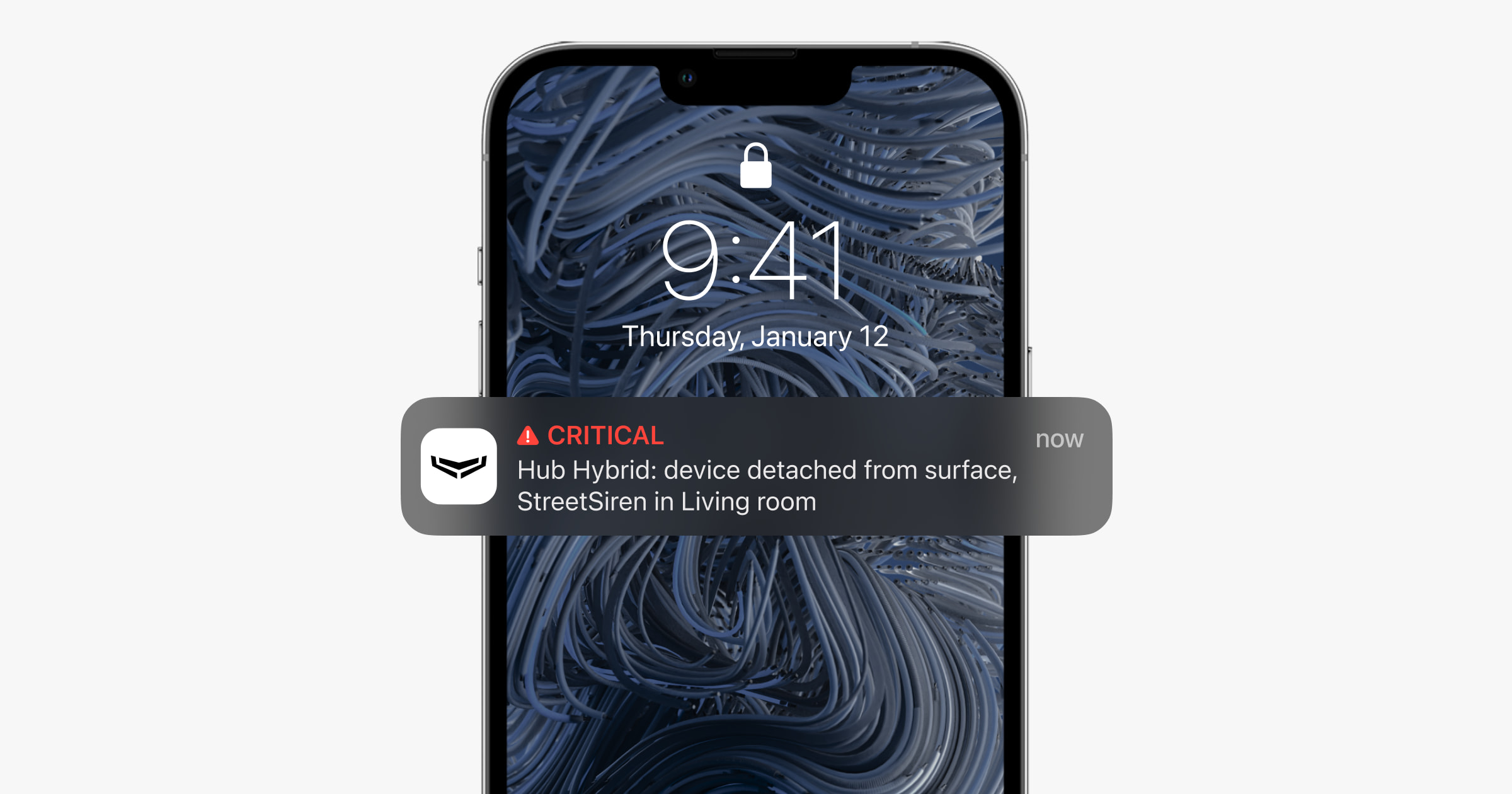
Fibra data transfer protocol

The siren uses Fibra technology to transmit alarms and events. This is a wired data transfer protocol that provides fast and reliable two-way communication between the hub and the connected devices. Using the bus connection method, Fibra delivers alarms and events instantly, even if 100 devices are connected to the system.
Fibra supports block encryption with a floating key and verifies each communication session with devices to prevent sabotage and spoofing. The protocol requires regular polling of devices by the hub with a predetermined frequency to monitor communication and display the status of the system devices in the Ajax apps.
Sending events to the monitoring station
The Ajax system can transmit alarms to the PRO Desktop monitoring app, as well as to the central monitoring station (CMS) using SurGard (Contact ID), SIA (DC-09), ADEMCO 685, and other proprietary protocols. The list of supported protocols is available here.
Superior StreetSiren Fibra can transmit the following events:
- Tamper alarm/recovery.
- Alarm due to loss/restoration of the main power.
- Loss/recovery of connection between Superior StreetSiren Fibra and the hub.
- Turning the siren off/on.
- Battery discharge/charge.
- Battery disconnection/connection.
When an alarm is received, the monitoring station operator of the security company knows what happened and where the rapid response unit has to be sent. Addressability of Ajax devices allows you to transmit to PRO Desktop and to the CMS events, device type, its assigned name and location (room, group). The list of transmitted parameters may differ depending on the type of CMS and the selected communication protocol.
Device ID, loop (zone) number, as well as line number can be found in its states.
Selecting the installation site
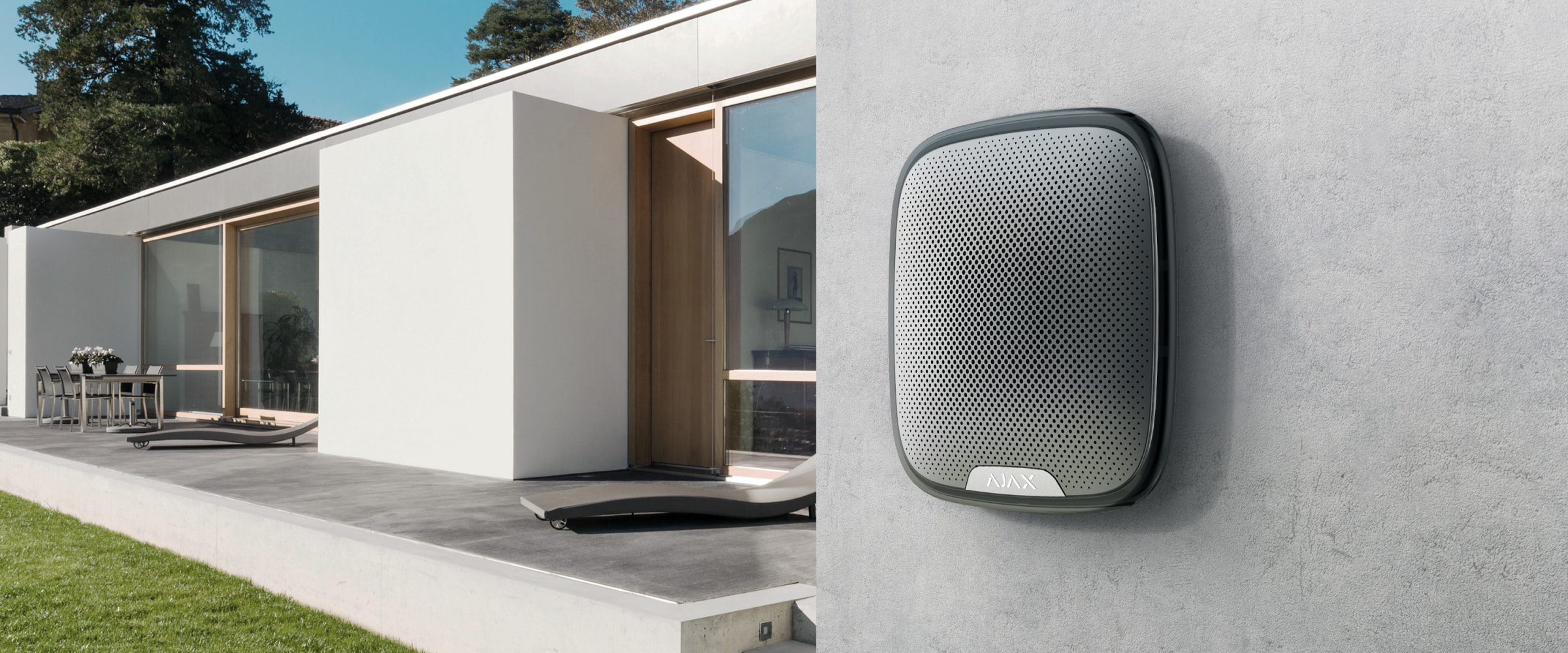
When choosing where to place Superior StreetSiren Fibra, take into account the parameters that affect the operation of the siren:
- Fibra signal strength.
- Cable length for connecting Superior StreetSiren Fibra.
- Audibility of Superior StreetSiren Fibra.
- Visibility of Superior StreetSiren Fibra LED indication.
Superior StreetSiren Fibra withstands heat, cold, and temperature drops. The siren is protected from rain and snow and can be installed on the facade of the building without a canopy. The siren enclosure has an IP54 protection class.
The recommended installation height is 2.5 meters or more. This raises difficulties for intruders to gain access to the device in the event of a sabotage attempt. If the siren cannot be placed at this height, it can be installed lower.
Follow placement recommendations when designing the Ajax system for an object. The security system should be designed and installed by professionals. The list of authorized Ajax partners is available here.
Do not install the siren
- Near glass break detectors. The siren sound may trigger an alarm.
- In places where the audio signal of the siren can be jammed.
- In places where the LED indication of the siren will not be visible.
- In places with low or unstable Fibra signal strength.
Fibra signal strength
The Fibra signal strength is determined by the ratio of the number of undelivered or corrupted data packages to those expected over a certain period of time. The icon in the Devices
tab in Ajax apps indicates the signal strength:
- Three bars — excellent signal strength.
- Two bars — good signal strength.
- One bar — low signal strength; stable operation is not guaranteed.
- Crossed out icon — no signal; stable operation is not guaranteed.
The following factors affect the signal strength:
- The number of devices connected to one Fibra line.
- Cable length and type.
- The correctness of the wire connections to the terminals.
Design
To correctly install and configure the system devices, it is important to properly design the system. The design must take into account the number and types of devices at the object, their exact location and installation height, the length of wired Fibra lines, the type of cable used, and other parameters. Tips for designing Fibra wired systems are available in this article.
Topologies
Ajax systems support two topologies: Beam (Radial) and Ring.
Beam connection (Radial wiring) occupies one line output of the hub. Only the segment that remains physically connected to the hub will function in the event of a line break. All devices connected after the breakpoint will lose connection with the hub.

Ring connection occupies two line outputs of the hub. If the ring breaks in one place, no device will be disabled. The ring reconfigures into two lines, which continue to operate normally. Users and the security company will receive notification of the break.

| Beam (Radial wiring) | Ring |
| Occupies one line output of the hub. Up to 8 beams on the same hub. Up to 2,000 m of wired communication for the same line. A terminating resistor is installed at the end of the line. |
Occupies two line outputs of the hub. Up to 4 rings on the same hub. Up to 500 m of wired communication for the same ring. No terminating resistor is installed at the end of the line. |
Both device connection topologies can be used on the same hub. For example, you can use two Ring connections and four Beam (Radial) connections.
Different types of devices can be connected to the same Fibra line. For example, you can connect opening detectors, motion detectors with photo verification support, sirens, and keypads to the same line.
The devices are connected to the Fibra line one by one, as shown on the figure. Line branching is not supported.

For the Beam (Radial) topology, be sure to install a 120 Ohm terminating resistor at the end of the line (included in the hub complete set). The terminating resistor is connected to the signal terminals of the last device in the line.

Cable length and type
The maximum communication range for wired connection using the Beam (Radial) topology is 2,000 meters, and that using the Ring topology is 500 meters.
Recommended cable types:
- U/UTP cat.5 4 × 2 × 0.51, copper conductor.
- Signal cable 4 × 0.22, copper conductor.
If you use a different type of cable, the communication range for wired connection may vary. No other types of cables have been tested.
Verification using a calculator

To make sure that the project is calculated correctly and such a system will work in practice, we have developed a Fibra lines distance calculator. The calculator helps to check the quality of communication and cable length for wired Fibra devices with the selected configuration at the system design stage.
Additional information
The maximum power that the Superior Hub Hybrid can supply to all Fibra lines in total is 0.6 W. The total current consumption of the devices in the system depends on the type of cable, its length, the type of connected device, the quality of the connection of conductors, and other factors. Therefore, after selecting devices, we recommend verifying the project using the Fibra calculator.
You can connect up to 100 devices to Superior Hub Hybrid by default.
Preparing for installation
Cable arrangement
When preparing to lay cables, check the electrical and fire safety regulations in your region. Strictly follow these standards and regulations.
It is safest to route cables inside walls, floors, and ceilings; this way, they will be invisible and unavailable for intruders. It also ensures their greater durability: the cable will be affected by fewer external factors affecting the natural wear of the conductor and its insulating layer.
As a rule, system cables are laid at the construction or repair stage, after the object has been wired.
If impossible to install cables inside the walls, route them so that the cable is sufficiently protected and hidden from prying eyes. For example, in a cable conduit or a protective corrugated pipe. It is recommended to hide them. For example, behind the furniture.
We recommend using protective pipes, cable conduits, or corrugated pipes to protect cables, regardless of whether they are routed inside the wall or not. The cables should be arranged carefully; no sagging, tangling, or twisting is allowed.
Consider the locations of possible signal interference. If the cable is routed near motors, generators, transformers, power lines, control relays, and other sources of electromagnetic interference, use twisted-pair cable in these areas.
Cable routing
When laying system cables, take into account not only the general requirements and rules for electrical installation work, but also the specifics of the installation of each device: installation height, method of fastening, how the cable is inserted into the casing and other parameters.
Before installation, we recommend you read the Selecting the installation site section of this manual. Avoid deviations from the system project. Violation of the basic installation rules and the recommendations of this manual lead to incorrect operation, as well as loss of connection with the Superior StreetSiren Fibra.
Check the cables for bends and physical damage before routing. Replace the damaged cables.
The signal cables for the system devices must be laid at a distance of at least 50 cm from the power cables when laid in parallel, and in case of their intersection, the angle must be 90°.
Observe the permissible bend radius of the cable. It is specified by the manufacturer in the cable specifications. Otherwise, you risk damaging or breaking the conductor.
Preparing cables for connection
Remove the insulating layer of the cable and strip the cable with a special insulation stripper only. It strips the cable properly without damaging the conductor. The ends of the wires that will be inserted into the terminals of the device must be tinned or crimped with a sleeve. This ensures reliable connection and protects the conductor from oxidation. Recommended cable lug sizes: 0.75 to 1 mm².
Installation and connection
Before installing the siren, make sure that you have selected the optimal location for the device and that it complies with the requirements of this manual. To reduce the risk of sabotage, the cables must be hidden from view and located in a place that is difficult for intruders to access.
Ideally, the cables should be set into the walls, floor, or ceiling. Before final installation, run the Volume Test and Fibra Signal Strength Test.
When connecting to the device terminals, do not twist the wires together; solder them. The ends of the wires that will be inserted into the terminals should be tinned or crimped with special end sleeves. This will ensure a reliable connection. Follow safety procedures and regulations for electrical installation work.
Connecting Superior StreetSiren Fibra to the hub
- Turn off lines power in Ajax PRO app. The function is available in the lines menu:
- Hub → Settings → Lines → Lines Power Supply.
- Plug the cable for the device connection into the hub casing. Connect the wires to the required hub line.
+24V — 24 V⎓ power terminal.
A, B — signal terminals.
GND — ground. - Remove the SmartBracket mounting panel from the device and carefully break out the perforated part to output the cable from the backside. If it is necessary to output cable from the bottom or the side, make holes in the places indicated in the figure using a drill.
1 — for cable output from the bottom of the siren.
2 — for cable output through the wall. - If the siren is not the last device in the connection line, prepare a second cable in advance. The ends of the wires of the first and second cables that will be inserted into the terminals of the device should be tinned and soldered together.
- Connect the wires to the terminals according to the figure below. Be sure to follow the polarity and connection order of the wires. Securely fasten the cable to the terminals. Secure the cable with ties.
+24V — power
А, B — signal terminals
GND — ground - If the siren is the last device in the line and the Beam topology (Radial wiring) is used, install a terminating resistor by connecting it to the signal terminals of the device. When the Ring connection method is used, a terminating resistor is not needed.
- Temporarily fix the SmartBracket panel to a vertical surface. This is necessary to run the device tests. The recommended installation height is 2.5 meters or more.
- Install the device on the SmartBracket mounting panel.
- Turn on lines power in the Ajax PRO app (Hub → Settings → Lines → Lines Power Supply). When power is applied, the LED will notify that the device is turned on.
- Add Superior StreetSiren Fibra to the system.
- Run the Fibra Signal Strength Test. The recommended signal strength is two or three bars. If the signal strength is one or zero bars, check the connection correctness and the cable integrity.
- Run the Volume Test. If the siren is hard to hear, change the volume or move the device.
- If the device passes the tests, fix the SmartBracket mounting panel with bundled screws using at least two fixing points (one of them is in the perforated part of the mount above the tamper). When using other fasteners, make sure they do not damage or deform the mounting panel.
Don’t use double-sided adhesive tape for temporary or permanent fixation of the siren, as the device may come off the surface at any time.
- Put the device onto the SmartBracket mounting panel and fix it with the bundled screw.
- Secure the siren with a screw. This reduces the risk of burglary and sabotage.
Adding to the system
The siren is only compatible with Superior Hub Hybrid (2G) and Superior Hub Hybrid (4G). Fibra devices can only be added and configured through Ajax PRO apps by a user with rights to configure the system.
Before adding a device
- Install an Ajax PRO app.
- Log in to a PRO account or create a new one.
- Select a space or create a new one.
The space functionality is available for apps of such versions or later:
- Ajax Security System 3.0 for iOS;
- Ajax Security System 3.0 for Android;
- Ajax PRO: Tool for Engineers 2.0 for iOS;
- Ajax PRO: Tool for Engineers 2.0 for Android;
- Ajax PRO Desktop 4.0 for macOS;
- Ajax PRO Desktop 4.0 for Windows.
- Add at least one virtual room.
- Add a compatible hub to the space. Ensure the hub is switched on and has internet access via Ethernet, Wi-Fi, and/or mobile network.
- Ensure the space is disarmed, and the hub is not starting an update by checking statuses in the Ajax app.
How to add Superior StreetSiren Fibra
There are two ways to add sirens via Ajax apps: manually and automatically.
To add a siren manually:
- Open the Ajax PRO app. Select the hub you want to add Superior StreetSiren Fibra to.
- Go to the Devices
tab and select Add Device.
- Assign a name to the device.
- Scan or type in the QR code manually. The QR code is located on the back of the enclosure under the SmartBracket mounting panel and on the packaging.
- Select a virtual room and a security group (if the Group mode is enabled).
- Press Add.
To add the siren automatically:
- Open the Ajax PRO app. Select the hub you want to add Superior StreetSiren Fibra to.
- Go to the Devices
tab and select Add Device.
- Select Add All Fibra Devices. The hub will scan all Fibra lines. After scanning, the Devices tab will show all devices physically connected to the hub that have not yet been added to the system. The order of the devices will depend on which line of the hub they are connected to.
- In the list of available devices to add, select the device you need. The LED indicator of this device will start flashing. This way, you’ll know exactly which device you’re adding, how to name it correctly, and which room and group it should be assigned to.
- To add a device, specify a name, room, and security group if the group mode is enabled. Press Save. If the device is added to the hub successfully, it disappears from the list of devices available for adding and appears in the Devices tab in the app.
Device status updating depends on the Fibra settings; the default value is 36 seconds.
If the connection fails, check if the wired connection is valid and try again. If the hub already has the maximum number of devices added (for Superior Hub Hybrid, the default value is 100), you will get an error notification when you add one.
Please note that only 10 sirens or keypads with a built-in siren can be connected to one hub.
Superior StreetSiren Fibra works with one hub only. After connecting to a new hub, the siren stops exchanging commands with the old one. Once added to a new hub, Superior StreetSiren Fibra is not removed from the list of devices of the old hub. This must be done manually in Ajax apps.
Device Self-test
The Ajax system provides several tests for the correct choice of the device installation place. The test does not start straight away but not later than over a single “hub — device” ping period (36 seconds under default settings of the hub). You can change the ping period of devices in the Fibra menu of the hub settings.
Tests available for Superior StreetSiren Fibra:
- Fibra Signal Strength Test. The test allows you to check a signal strength and stability at the installation site.
- Volume Test. Allows you to check the current siren volume level and select the optimal volume level for the protected object.
To run a test:
- Select the hub if you have several of them or if you are using the Ajax PRO app.
- Go to the Devices
menu.
- Select Superior StreetSiren Fibra.
- Go to the Superior StreetSiren Fibra settings by clicking on the gear icon
.
- Select:
- Run the test following the prompts of the app.
Icons
The icons show some of the device states. You can view them in Ajax apps in the Devices tab.
| Icon | Meaning |
|
Fibra Signal Strength — displays the signal strength between the hub and the device. Recommended values: 2–3 bars. |
|
| Siren notifies about the opening. | |
| The battery charge level of the device. | |
|
Superior StreetSiren Fibra has been deactivated. |
|
|
Superior StreetSiren Fibra tamper triggering events are disabled. |
|
| The device has lost connection with the hub or the hub has lost connection with the Ajax Cloud server. | |
|
The device has not been transferred to the new hub. |
States
The states include information about the device and its operating parameters. Superior StreetSiren Fibra states can be found in the Ajax apps:
- Go to the Devices
tab.
- Select Superior StreetSiren Fibra from the list of devices.
| Parameter | Meaning |
| Data import | Displays the error when transferring data to the new hub:
|
| Malfunction |
Clicking on The field is displayed only if a malfunction is detected. |
| Temperature |
Siren temperature. Acceptable error between the value in the app and the room temperature — 2°C. The value is updated as soon as the siren identifies a temperature change of at least 1°C. You can configure a scenario by temperature to control automation devices. |
| Fibra Signal Strength |
Signal strength between the hub and Superior StreetSiren Fibra. The recommended value is two or three bars. Fibra is a protocol for transmitting Superior StreetSiren Fibra events and alarms. |
| Connection via Fibra | The status of connection between the hub and the siren:
|
| Line Voltage | The voltage value on the Fibra line to which the siren is connected. |
| Battery Сharge | The battery charge level of the device. Two statuses are available:
The indication of the battery charge on the Fibra line is displayed with the |
| Lid | The tamper status that responds to the detachment of the device from the surface or violation of the casing integrity:
|
| Alarm Volume | Volume level in case of alarm:
The volume level is measured 1 m away from the siren. |
| Alarm Duration |
Duration of sound signal in case of alarm: from 3 seconds to 3 minutes. Sets in increments of 3 seconds. |
| LED indication | Settings of the siren LED indication:
|
| Beeps Settings | |
| Arming/Disarming | When enabled, the siren notifies about arming and disarming by flashing the LED and a short beep. |
| Night Mode Activation/Deactivation | When enabled, the siren notifies you when the Night mode is switched on/off by flashing the LED and making a short beep. |
| Entry Delays | When the option is enabled, the siren signals Delay When Entering with a short beep. |
| Exit Delays | When the option is enabled, the siren signals Delay When Leaving with a short beep. |
| Entry Delays in Night mode | When enabled, the siren beeps to signal about a delay when entering in the Night Mode. |
| Exit Delays in Night mode | When enabled, the siren beeps to signal about a delay when leaving in the Night Mode. |
| Chime on opening |
When the option is enabled, the siren notifies about the triggering of the opening detectors in the system mode Disarmed. |
| Beep Volume | Volume of the audible notification signal about arming/disarming, entry/exit delay, opening detector triggering:
The volume level is measured 1 m away from the siren. |
| Permanent Deactivation | Shows the status of the device deactivation function:
|
| Firmware | Superior StreetSiren Fibra firmware version. |
| Device ID | Superior StreetSiren Fibra ID/serial number. Also available on the back of the siren enclosure and on the packaging. |
| Device No. | Superior StreetSiren Fibra loop (zone) number. |
| Line No. | The number of the Fibra line of a hub to which Superior StreetSiren Fibra is physically connected. |
Settings
To change the siren settings in the Ajax app:
- Go to the Devices
tab.
- Select Superior StreetSiren Fibra from the list.
- Go to Settings by clicking on the gear icon
.
- Set the required settings.
- Click Back to save the new settings.
| Settings | Meaning |
| Name |
Siren name. Displayed in the list of hub devices, SMS text, and notifications in the events feed. To change the name, click on the text field. The name can contain up to 12 Cyrillic characters or up to 24 Latin characters. |
| Room |
Choosing a Superior StreetSiren Fibra virtual room. The room name is displayed in the text of SMS and notifications in the events feed. |
| Audible alarm | Selecting when to enable audible alarm:
Setting is available for hubs with the firmware version OS Malevich 2.16 or later. |
| Notify if device temperature is outside normal range |
When enabled, the system sends notifications about temperature changes affecting battery charging. This setting is enabled by default. |
| Alarms in Group mode | Selecting the group to which the siren is assigned. You can select one or all groups:
Regardless of the selected group, the siren will respond to activation and alarms of the Night Mode. The option is displayed if group mode is enabled on the hub. |
| Alarm volume | Volume level in case of alarm:
The volume level is measured 1 m away from the siren. |
| Alarm duration |
Duration of a sound signal in case of alarm: from 3 seconds to 3 minutes. Set in 3 second intervals. |
| LED indication | Settings of the siren LED indication:
|
| Beeps settings |
Opens the siren beeps settings. A description of all alert settings is available below. |
| Activate buzzer if lid is open |
When enabled, the siren will be activated when a tamper triggering is detected. |
| Activate buzzer if power supply from the line is insufficient | When enabled, the siren will be activated when a loss of main power is detected. |
| Fibra signal strength test |
Switches the siren to the Fibra signal strength test mode. The test allows you to check the signal strength between the hub and the siren via the Fibra wired communication protocol to select the optimal installation location. |
| Volume test |
Switches the siren to the volume test mode. The test allows you to check the current siren volume level and select the optimal volume level for the protected object. |
| User guide | Opens Superior StreetSiren Fibra User Manual in the Ajax app. |
| Permanent deactivation |
Allows the user to disable the device without removing it from the system. Three options are available:
|
| One-time deactivation |
Allows the user to disable events of the device until the first disarm. Three options are available:
|
| Delete device | Unpairs Superior StreetSiren Fibra from the hub and deletes its settings. |
Beeps Settings
Beep on armed mode change
| Event | Description | Note |
| Arming/Disarming | When enabled, the siren notifies you when the system is armed and disarmed by lighting the LED frame and making a short beep. | The brightness of the indication and the volume of the sound signal depend on the siren settings. Light and/or sound indication can be turned off in the siren settings. |
| Night Mode Activation/Deactivation | When enabled, the siren notifies you when the Night mode is switched on/off by lighting the LED frame and making a short beep. | The brightness of the indication and the volume of the sound signal depend on the siren settings. Light and/or sound indication can be turned off in the siren settings. |
Beep on Delays
| Entry Delays |
When enabled, the siren beeps to signal about a delay when entering. |
| Exit Delays |
When enabled, the siren beeps to signal about a delay when leaving. |
| Entry Delays in Night Mode |
When enabled, the siren beeps to signal about a delay when entering in the Night Mode. |
| Exit Delays in Night Mode |
When enabled, the siren beeps to signal about a delay when leaving in the Night Mode. |
Beep when Disarmed
| Chime on opening |
When this option is enabled, the siren informs you with a short beep that the opening detectors are triggered in the Disarmed system mode. |
Siren beep volume
| Beep Volume | Selecting the siren volume level for notifications about arming/disarming, entry/exit delay, and opening:
The volume level is measured 1 m away from the siren. |
Setting the siren response to device alarms
In Ajax apps, you can separately configure the siren’s reaction to the alarms of each detector in the system. The function is useful if you do not need to activate the siren in case of the alarm of a specific device. For example, to LeaksProtect leakage detector triggering.
To set the siren response to a device alarm
- Open the Ajax app.
- Go to the Devices
tab.
- Select the device for which you want to configure the siren response from the list.
- Go to the device Settings by clicking on the gear icon
.
- Find the Alert with a siren option and select the toggles which will activate it. Enable or disable the function.
- Repeat steps 3-5 for the rest of the system devices.
By default, the siren response is enabled for alarms of all devices in the system.
Setting the tamper alarm response
In Ajax apps, you can configure the siren’s response to casing alarms of each system device. When the function is activated, the siren will emit a sound signal when triggering the tamper button of device.
To set the siren response to a tamper alarm
- Open the Ajax app.
- Go to the Devices
tab.
- Select a hub and go to its Settings
.
- Select the Service menu.
- Go to section Sounds and Alerts.
- Enable the Alert with a siren if the hub or detector lid is open option.
- Click Back to save the new settings.
Tamper button reacts to opening and closing of the casing, regardless of the armed mode of the device or system.
Setting the response to pressing the panic button in Ajax apps
You can configure the siren response to alarm when the panic button is pressed in the Ajax apps.
To configure the siren’s response to pressing the panic button in Ajax apps
- Open the Ajax app.
- Go to the Devices
tab.
- Select a hub and go to its Settings
.
- Select the Service menu.
- Go to section Sounds and Alerts.
- Enable the Alert with a siren if in-app panic button is pressed option.
- Click Back to save the new settings.
Setting the siren after-alarm indication

The siren can inform about triggering in the armed system by means of LED indication.
The option functions as follows:
- The system registers the alarm.
- The siren plays an alarm signal. The duration and volume of the signal depend on the device settings.
- The lower right corner of the siren LED frame flashes twice (once every 3 seconds) until the system is disarmed.
Thanks to this feature, system users and passing security companies patrols can see that the system was triggered.
The siren after-alarm indication does not work for always active detectors, if the detector was triggered when the system was disarmed.
To enable the siren after-alarm indication, in Ajax PRO app:
- Go to the siren settings:
- Hub → Settings → Service → Sounds and Alerts.
- Specify which events the sirens will inform about by double blinking of the LED indicator before the system is disarmed:
- Confirmed intrusion/hold-up alarm
- Single intrusion/hold-up alarm
- Lid Opening
- Press Select Devices and select the required sirens. The new parameters will be saved.
- Click Back. All settings will be applied.
How to set up Chime
If Chime on opening is enabled, the sirens notify you with a short beep if the opening detectors are triggered when the system is disarmed. The feature is used, for example, in stores, to notify employees that someone has entered the building.
Notifications are configured in two stages: setting up sirens and setting up opening detectors.
To set up a siren
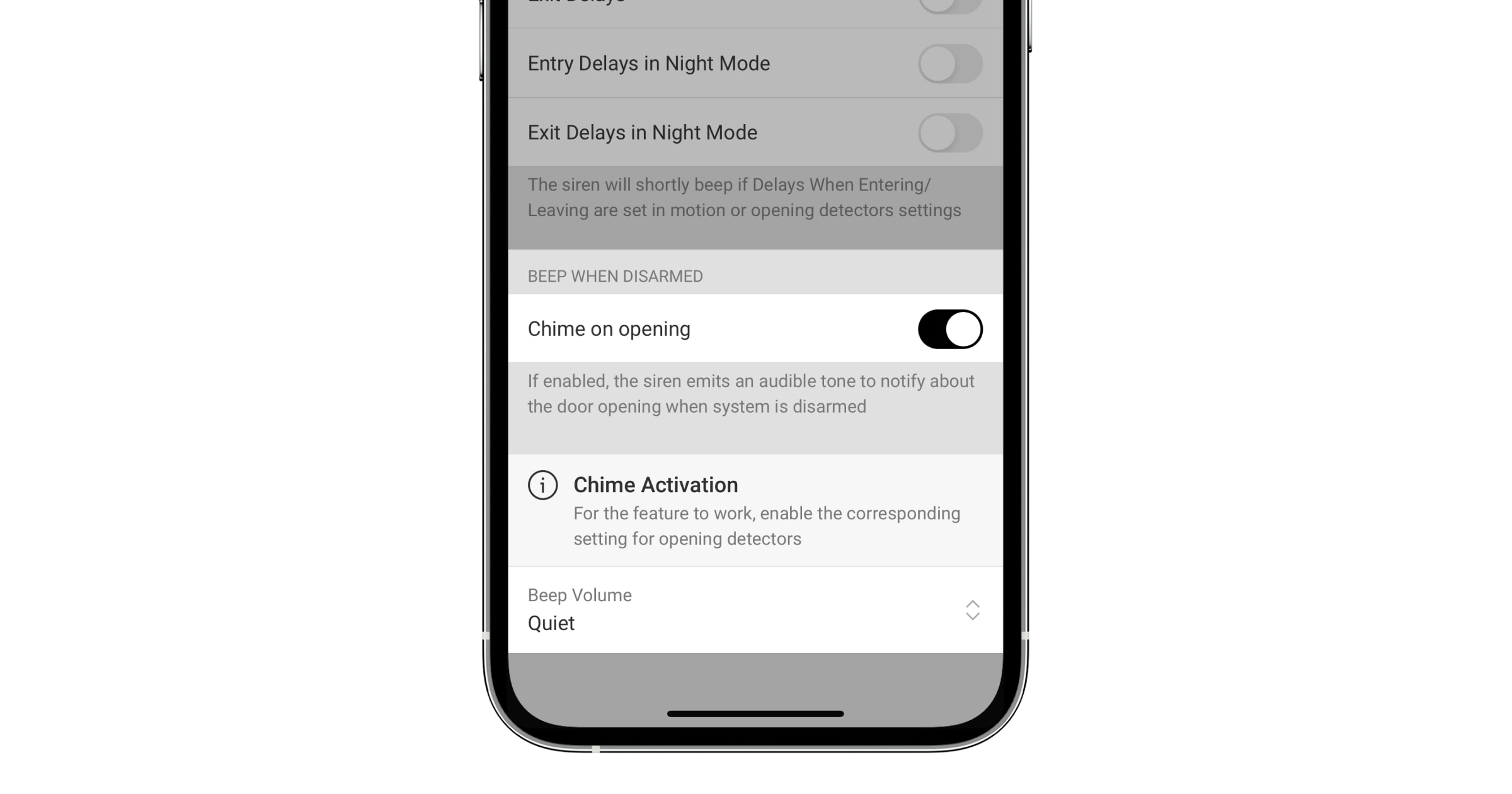
- Go to the Devices
tab.
- Select the required siren from the list.
- Go to siren Settings by clicking on the gear icon
in the upper right corner.
- Go to the Beeps Settings menu.
- Enable the Chime on opening option in the Beep when Disarmed category.
- Set the volume of the beeps. 3 options are available:
- Quiet — 85 dB, measured at a distance of 1 m from the siren.
- Loud — 100 dB, measured at a distance of 1 m from the siren.
- Very loud — 113 dB, measured at a distance of 1 m from the siren.
The specified Beep Volume also applies to the volume of beeps when arming/disarming and the delay when entering/leaving.
- Click Back to save the settings.
- Repeat steps 2–7 for other sirens for which you want to enable beeps.
- Set up the opening detector.
Indication
| Event | Indication | Note |
| Alarm. | Beeps, the LED frame flashes red. | The duration and volume of the sound signal depend on the siren settings. |
|
An alarm is detected in the armed system (if the post-alarm indication is on). |
The siren LED frame flashes red twice in the lower right corner every 3 seconds until the system is disarmed. | The indication turns on after the siren has fully played the alarm signal. |
|
The system is armed (if Beep on Armed Mode Change is enabled). |
The frame blinks once, the siren emits a short beep. | The volume of the sound signal depends on the Beeps Volume settings. |
|
System is disarmed (if Beep on Armed Mode Change is enabled). |
The LED frame flashes twice, the siren emits two short beeps. | The volume of the sound signal depends on the Beeps Volume settings. |
|
Siren in the armed mode (if the indication is configured in Armed mode). |
The LED frame in the lower right corner flashes once per second. |
Maintenance
Check the functioning of your siren on a regular basis. The optimal frequency of checks is once every three months. We recommend you check the fixation tightness of the wires in the siren terminals.
Clean the siren enclosure from dust, cobwebs, and other contaminants as they emerge. Use a soft dry cloth suitable for equipment care.
Do not use substances that contain alcohol, acetone, gasoline, or other active solvents to clean the siren.
Technical specifications
Complete set
- Superior StreetSiren Fibra.
- SmartBracket mounting panel.
- Installation kit.
- Quick Start Guide.
Warranty
Warranty for products of Limited Liability Company “Ajax Systems Manufacturing” is valid for 2 years after purchase.
If the device does not function correctly, please contact Ajax Technical Support first. In most cases, technical issues can be resolved remotely.
Contact Technical Support
Manufactured by “AS Manufacturing” LLC
